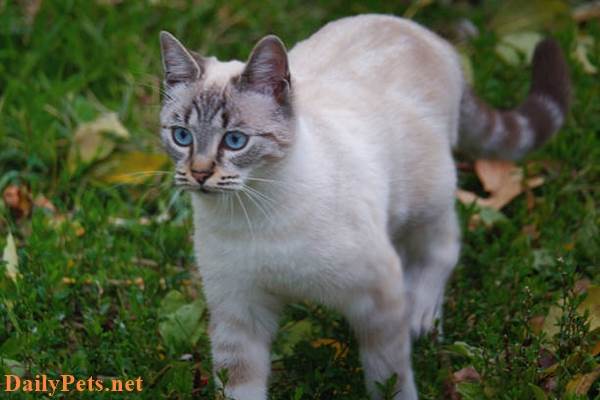Let’s learn about the Scottish Fold Cat with DailyPets.net through this article.
Learn about the Scottish Fold cat breed
Scottish Fold Cat Origins
In 1960, the first Scottish Fold cat was found on a Scottish farm named Susie. Many people were surprised and curious to see this species. Researchers have proven that Susie is naturally genetically modified.
The Scottish Fold cat has become a pet not only of Americans but also imported to other countries. This cat breed has folded ears bent forward and down the head, which looks cute and funny. Perhaps that is why many pet owners love Scottish Fold cats.
Scottish Fold cat classification
This Scottish Fold cat has a small body that resembles a soft cotton ball. With a round figure, big round eyes like marbles, and four cute short legs that have captivated many pet lovers.

In the great family of Scottish Fold cats, the folds are divided into 4 different types, each distinct feature.
- Single Easy Fold: There is a slight difference in the ears; the ears are slightly tilted and reclined with the fold in the cartilage bone, forming an L shape. The ears’ folds are no longer obvious; they are often teased as faulty folded ears.
- Single Fold: Cats have cartilaginous folds in the ears to form a V shape, curvier than the Single Easy Fold, but not close to the head. These cats can be bred with the Scottish Fold to produce a Double or Triple Ford cat.
- Double Fold: This cat breed will have W-shaped ears, very close to the head and almost invisible.
- Triple Fold: This cat breed is similar to Double Ford in W-shaped ears but different in that it has maximum folded ears, no longer seeing cat ears.
Popular Scottish Fold cat coat colors
Scottish Fold cats have a variety of coat colors, such as black, white, red, chocolate, …

Scottish Fold cat appearance characteristics
The Scottish Fold is a breed of cat that was born thanks to genetic variation in the wild. Their appearance is somewhat different, with drooping ears hugging their heads, short legs, and round bodies. This is also an easily identifiable feature with other cat breeds.
Scottish Fold personality traits
Scottish Fold cats have a friendly, gentle personality that adapts well to any living environment. This is an intelligent cat, calm in all situations. They love to cuddle with their owners and get along with other animals. Because of the inactivity, the Scottish Fold cat is very fat.
How to take care of a Scottish Fold cat
Scottish Fold cat food
In each meal, you just need to pay attention to the nutrition because the Scottish Fold cat has a very good digestive system and rarely has intestinal diseases.
Scottish Fold cat food includes fish, vegetables, chicken, ready-to-eat seeds, and pate. Besides, you also have to ensure the number of meals a day for them.
Scottish Fold cats should not eat certain foods such as cow’s milk, chocolate, garlic, onions, etc. When feeding Scottish Fold cats, you need to clean all utensils to avoid intestinal infections.
Scottish Fold cat’s diet by stage
- Stage 0 – 4 weeks: Scottish Fold cat food is mother’s milk, absolutely no external food.
- Stage 5 – 10 weeks: food should be pureed or in small granules. Besides, you should let them practice biting and tearing food so that their teeth can develop and divide the day’s meals from 5 to 6.
- From 10 to 15 weeks old: the recommended food for Scottish Fold cats is four meals/day.
- From 15 weeks onwards: reduce to 3 meals/day but still have to provide adequate nutrients for them.
How to care for and hygiene for Scottish Fold cats
Brush the Scottish Fold once a day to remove loose hair.
Scottish Fold cats need to be bathed 2-3 times/month, ensuring that the fur is completely removed from dirt and bacteria.
Common Scottish Fold cat health problems
Scottish Fold cats are prone to bone and cartilage diseases. This disease can cause cats to suffer from osteoarthritis, stiff tails, deformed legs, and larger than normal cats. In addition, Scottish Fold is prone to kidney disease and heart-related diseases.
Notes when taking care of Scottish Fold cats
You should be vaccinated and dewormed fully on a regular basis. Routine vet check-ups for your pet cat every 6 or 12 months. Cats should only be purchased at reputable addresses, without genetic problems, and only brought home when they are over 2 months old and have been vaccinated with 2 full doses. If there is no need to breed and raise kittens, neutering cats from 5 months old will help cats live longer.
Notes when buying Scottish Fold cats
You should only buy in reputable places; do not buy online because scamming is easy.
You should carefully identify the cat’s characteristics, shape, and health before buying and consult the price.
When you buy a fold-eared cat, you need an experienced person to follow up and ask about the cat’s age. To avoid buying a straight-eared Scottish Fold at the price of a fold-eared cat, you should choose to buy a cat that is 5 weeks old or older, at which point their folded and folded ears can be seen.
*Note: The Scottish Straight cat also originates in Scotland; the name also partly describes their characteristic of erect ears.
The Scottish Straight cat was confirmed to be related to the Scottish Fold cat in 2005. Scottish Straight cats also have 2 types, long-haired and short-haired.

Scottish Straight cat.





